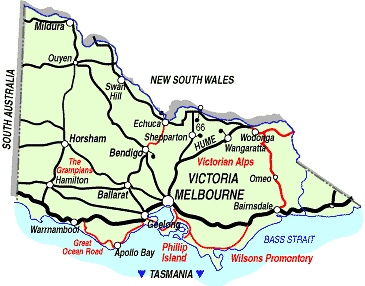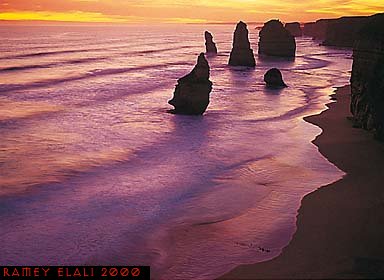![]() Deutschsprachige
Texte sind durch die deutsche Flagge markiert.
Deutschsprachige
Texte sind durch die deutsche Flagge markiert.

 Victoria
Victoria AREA: 227,600
sq. km, POPULATION: 3,500,000
CAPITAL: Melbourne (3,000,000)

CLIMATE: Highest
temp. 50.8° C at Mildura in the north-west. -12.8°C at
Mt. Hotham in the Highlands. High rainfall with extremes
of heat in summer in the western and north western
regions.
Melbourne was first settled in 1835. Victoria is
Australia's smallest mainland state with 1800 km of
coastline.
Known the 'Garden State', a reference to the rolling
green hills and valleys which make up the majority of the
state, and varied in scenery, it is has much to offer. To
the north the mighty River Murray makes up the bulk of
its border to New South Wales, while to the east and
south, the Tasman Sea, Bass Strait, and the Southern
Ocean have carved out a spectacular coastline which
varies from golden beaches to stark outcrops such as the
Port Campbell National Park. Also in the north is the
Alpine National Park, a skiing area which offers winter
sports from around June to September, and
mountain-climbing and exploration throughout the rest of
the year.
In the west of the state, close to its border with South
Australia, desert wilderness areas can be seen. The
Little Desert and Wyperfeld National Parks are renowned
for the wildflowers which bloom throughout the year,
mainly around September, and are popular walking and
exploring parks.
Among the major attractions of the state is The Grampians
National Park, west of Melbourne. This beautiful area
offers walking trails, spectacular lookouts and lake
swimming and fishing. South-east of Melbourne, Phillip
Island is a popular place to observe the nightly
procession of pengiuns returning to their nests after a
days activities.
The capital of Victoria, Melbourne, enjoys the reputation
of being Australia's Cultural capital, and this is
reflected in the many live shows which are presented at
the theatres which abound in the city.


click on the map for enlargement (and better quality)
| Melbourne | Jan | Feb | Mar | Apr | May | Jun | July | Aug | Sept | Oct | Nov | Dez |
| Temperature max. (C) | 26 | 26 | 24 | 20 | 17 | 14 | 13 | 15 | 17 | 20 | 22 | 24 |
| Temperature min. (C) | 14 | 14 | 13 | 11 | 9 | 7 | 6 | 6 | 8 | 9 | 11 | 13 |
| Rainfall (in mm) | 48 | 50 | 54 | 59 | 57 | 50 | 48 | 49 | 58 | 67 | 59 | 58 |
| Water Temperature (C) | 18 | 18 | 17 | 16 | 15 | 14 | 13 | 13 | 13 | 14 | 15 | 16 |
 Melbourne,
die Hauptstadt Victorias, ist mit einer Fläche von über
6.100 qkm eine Stadt gigantischen Ausmasses (zum
Vergleich: Sydney 4.100 qkm). Melbourne hat ein
gemäßigtes Klima. Die Innenstadt ist schachbrettartig
angelegt. Alle großen Straßen können hier direkt per
Straßenbahn erreicht werden. Die Vororte sind an ein gut
funktionierendes System von Vorortzügen (the Met)
angeschlossen. Zentralbahnhof für die Vorortzüge ist Flinders Street Station
(in der gleichnamigen Straße direkt am Yarra River
gelegen). Melbourne wurde sehr großzügig geplant. Die
nahe der Innenstadt gelegenen Parks
sind auf jeden Fall sehenswert. Ein Zoobesuch
ist ebenfalls lohnenswert, obwohl uns der Zoo in Sydney
besser gefällt. Weitere lohnenswerte Ziele: Queen Victoria Market
und Melbourne Central.
Melbourne ist im Vergleich zu Sydney relativ britisch.
Eine gewisse Rivalität zwischen beiden Städten ist seit
langem gegeben. Melbourne ist zwar nicht so spektakulär
wie Sydney gelegen, es lohnt sich aber trotzdem Melbourne
für die An- oder Abreise zu wählen. Der erste Grund
fällt schon bei der Ankunft in Melbourne auf. Es ist der
Flughafen, der einen weitaus gediegeneren und sauberen
Eindruck als der von Sydney macht. Der zweite Grund wiegt
aber viel schwerer: es sind die vielen lohnenswerten
Nationalparks und Naturschönheiten Victorias. Unserer
Meinung besonders empfehlenswert: Grampians
NP (viel Wald, Berge, Sittiche,
Kakadus, Känguruhs, Koalas, Emus; gut zum Wandern
geeignet), auf dem Weg dorthin bietet sich z.B. die
Besichtigung der Great
Ocean Road
an (hier befinden sich u.a. die 12
Apostels, die London
Bridge usw.; das Befahren der Great
Ocean Road erfordert Zeit - am besten einen ganzen Tag
einplanen), Wilsons
Promontory NP (atemberaubend schön -
viel Wald, Berge, Strände - leider ist das Wasser meist
zu kalt zum Baden - Sittiche, Wombats, Känguruhs, Emus,
Koalas; ebenfalls gute Wandermöglichkeiten), für Kinder
besonders interessant: Phillip
Island, nur zwei Autostunden von der
Stadtgrenze Melbournes entfernt (Pinguin
Parade, Koala Reserves,
empfehlenswert: Phillip
Island Wildlife Park, 2 km südlich
von Cowes).
Melbourne,
die Hauptstadt Victorias, ist mit einer Fläche von über
6.100 qkm eine Stadt gigantischen Ausmasses (zum
Vergleich: Sydney 4.100 qkm). Melbourne hat ein
gemäßigtes Klima. Die Innenstadt ist schachbrettartig
angelegt. Alle großen Straßen können hier direkt per
Straßenbahn erreicht werden. Die Vororte sind an ein gut
funktionierendes System von Vorortzügen (the Met)
angeschlossen. Zentralbahnhof für die Vorortzüge ist Flinders Street Station
(in der gleichnamigen Straße direkt am Yarra River
gelegen). Melbourne wurde sehr großzügig geplant. Die
nahe der Innenstadt gelegenen Parks
sind auf jeden Fall sehenswert. Ein Zoobesuch
ist ebenfalls lohnenswert, obwohl uns der Zoo in Sydney
besser gefällt. Weitere lohnenswerte Ziele: Queen Victoria Market
und Melbourne Central.
Melbourne ist im Vergleich zu Sydney relativ britisch.
Eine gewisse Rivalität zwischen beiden Städten ist seit
langem gegeben. Melbourne ist zwar nicht so spektakulär
wie Sydney gelegen, es lohnt sich aber trotzdem Melbourne
für die An- oder Abreise zu wählen. Der erste Grund
fällt schon bei der Ankunft in Melbourne auf. Es ist der
Flughafen, der einen weitaus gediegeneren und sauberen
Eindruck als der von Sydney macht. Der zweite Grund wiegt
aber viel schwerer: es sind die vielen lohnenswerten
Nationalparks und Naturschönheiten Victorias. Unserer
Meinung besonders empfehlenswert: Grampians
NP (viel Wald, Berge, Sittiche,
Kakadus, Känguruhs, Koalas, Emus; gut zum Wandern
geeignet), auf dem Weg dorthin bietet sich z.B. die
Besichtigung der Great
Ocean Road
an (hier befinden sich u.a. die 12
Apostels, die London
Bridge usw.; das Befahren der Great
Ocean Road erfordert Zeit - am besten einen ganzen Tag
einplanen), Wilsons
Promontory NP (atemberaubend schön -
viel Wald, Berge, Strände - leider ist das Wasser meist
zu kalt zum Baden - Sittiche, Wombats, Känguruhs, Emus,
Koalas; ebenfalls gute Wandermöglichkeiten), für Kinder
besonders interessant: Phillip
Island, nur zwei Autostunden von der
Stadtgrenze Melbournes entfernt (Pinguin
Parade, Koala Reserves,
empfehlenswert: Phillip
Island Wildlife Park, 2 km südlich
von Cowes).